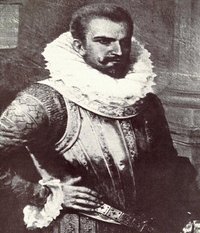Pedro de Alvarado
|
|
Pedro de Alvarado (Badajoz, c. 1495 - Guadalajara, Mexico, July 4, 1541), was one of the Spanish leaders in the discovery and conquest of America. He was known as one of the best soldiers among the Conquistadores, as well as one of the most cruel to the native populations.
Alvarado went to Hispaniola in 1510. He held a command in the Juan de Grijalva expedition sent from Cuba against Yucatán in the spring of 1518, and returned in a few months, bearing reports of the wealth and splendour of Moctezuma II's empire.
In February 1519 he accompanied, as chief lieutenant and second in command, Hernán Cortés in the expedition for the conquest of Mexico. Alvarado was being appointed to the command of one of the eleven vessels of the fleet. He acted as Cortés's principal officer, and on the first occupation of the Aztec capital city of Tenochtitlán he was left in command of the forces at Tenochtitlan, when Hernán Cortés had to move against Pánfilo de Narváez. When the Spaniards had temporarily to retire before the Mexican uprising, Alvarado led the rear-guard (July 1, 1520 see La Noche Triste) and the Salto de Alvarado--a long leap with the use of his spear, by which he saved his life--became famous.
Sent out by Hernan Cortés with 120 horsemen, 300 footsoldiers and several hundred Cholula and Tlascala auxiliaries, he was engaged in the conquest of the highlands of Guatemala from 1523 to 1527. At first Alvarado allied himself with the Cakchiquiel nation in his conquest of their traditional rivals the Quiché nation, but his cruelties alienated the Cakchiquiel, and he needed several years to stamp out resistance in the region. Pedro de Alvarado led the first effort by Spanish forces to extend their dominion to the future El Salvador in June 1524. Spanish efforts were firmly resisted by the indigenous people known as the Pipil and their Mayan speaking neighbors. Led by a war leader tradition calls Atlacatl, the indigenous people defeated the Spaniards and forced them to withdraw to Guatemala. Two subsequent expeditions were required --the first in 1525, followed by a smaller group in 1528-- to bring the Pipil under Spanish control. Alvarado was subsequently appointed governor of Guatemala by Charles I of Spain and remain governor of Guatemala until his death.
In 1534 Alvarado heard tales of the riches of Peru, headed south to the Andes and attempted to bring the province of Quito under his rule. When he arrived he found the land already held by Francisco Pizarro's lieutenant Sebastian de Belalcazar. The two forces of Conquistadors almost came to blows, but then Pizarro paid off Alvarado to leave.
During a visit to Spain, in 1537, Alvarado had the governorship of Honduras conferred upon him in addition to that of Guatemala for next 7 years.
Alvarado fought to suppress a major revolt by the Mixtón natives of the Nueva Galicia region of Mexico in 1541. After an unsuccessful assault on the fortified peak of Nochistlan, Alvarado was leading a retreat when he was crushed by a horse that lost its footing. He died a few days later, on July 4, 1541, and was buried in the church at Tiripetio (Michoacán). Four decades later, his daughter Leonor Alvarado Xicotencatl paid to transport his remains to Guatemala for reburial in the cathedral of the city of Santiago (now Antigua Guatemala).
External links
- Catholic Encyclopedia:Pedro de Alvarado (http://www.newadvent.org/cathen/01372d.htm)de:Pedro de Alvarado
es:Pedro de Alvarado fr:Pedro de Alvarado nl:Pedro de Alvarado pt:Pedro de Alvarado

